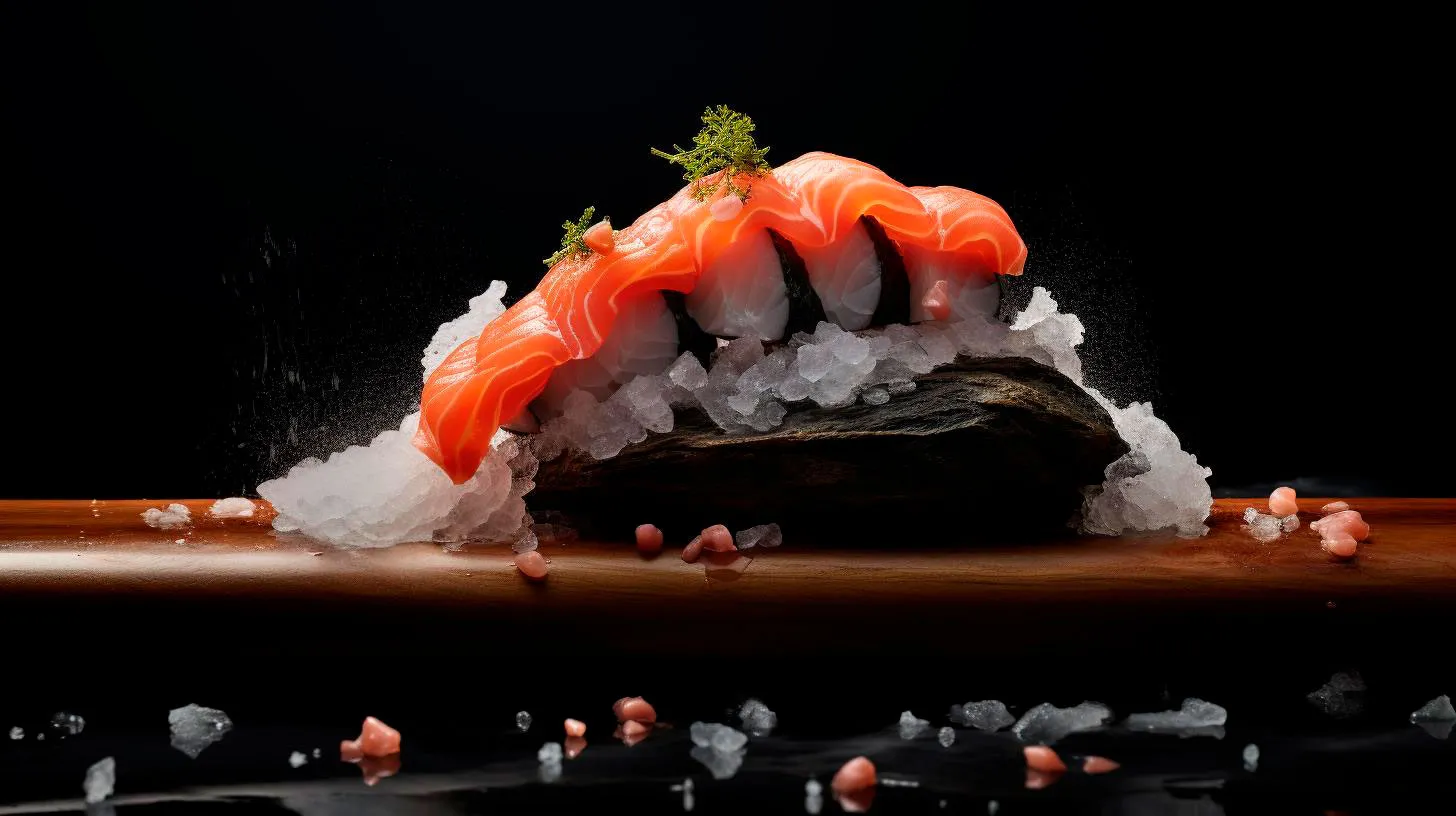From Root to Plate: Understanding the Fermentation Steps of Pickled Ginger
In this article, we will take a closer look at the fermentation steps involved in making pickled ginger and unravel the secrets behind its unique flavor profile.
The Roots of Pickled Ginger
Ginger, scientifically known as Zingiber officinale, is a root that has been used in traditional medicine for centuries. Its antioxidant and anti-inflammatory properties have made it a popular ingredient in various cuisines around the world. In the case of pickled ginger, young ginger roots are used due to their mild and tender nature. These roots are typically harvested early in the growing season, resulting in a softer texture and subtle flavor.
Before the fermentation process begins, the ginger roots undergo several pre-treatment steps:
- Washing: The ginger roots are thoroughly washed to remove any dirt or impurities.
- Peeling: The outer skin of the ginger roots is carefully peeled off.
- Slicing: The peeled roots are then thinly sliced using a sharp knife or a mandoline slicer.
- Blanching: The ginger slices are briefly blanched in boiling water to soften them and remove any residual pungency.
Once the pre-treatment steps are complete, the ginger slices are ready for the fermentation process.
The Fermentation Process
Fermentation is a natural process that involves the conversion of sugars into acids, gases, or alcohol by microorganisms such as bacteria or yeast. In the case of pickled ginger, lactic acid fermentation is employed to achieve its distinctive taste and texture. Here are the key steps involved:
1. Brining
The ginger slices are first soaked in a brine solution, which usually consists of water, vinegar, sugar, and salt. This brine solution provides the ideal environment for beneficial bacteria to thrive while inhibiting the growth of harmful microorganisms. Brining also helps to draw out excess moisture from the ginger slices, allowing them to become more flavorful and crunchy.
Key Takeaway: Brining enhances the flavor and texture of pickled ginger while protecting it from spoilage.
2. Lacto-Fermentation
The brined ginger slices are then placed in an airtight container and left to ferment at room temperature for several days. During this time, naturally occurring bacteria, primarily from the Lactobacillus family, convert the sugars in the ginger slices into lactic acid. This fermentation process results in the tangy and acidic taste that defines pickled ginger.
Key Takeaway: Lacto-fermentation is responsible for the unique flavor profile of pickled ginger, providing its signature tangy taste.
3. Flavor Infusion
After the initial fermentation, additional flavors can be infused into pickled ginger to create variations in taste. Common additions include rice vinegar, mirin (a sweet rice wine), and natural coloring agents like beet juice or turmeric. These additions not only enhance the flavor but also give pickled ginger its iconic pink or yellow color.
Key Takeaway: Flavor infusion allows for customization of pickled ginger, adding complexity to its taste profile.
Advantages of Pickled Ginger Fermentation
The fermentation process involved in making pickled ginger offers several advantages:
- Improved Digestion: Fermentation increases the bioavailability of nutrients, making them easier to digest and absorb.
- Probiotic Benefits: Lactic acid fermentation promotes the growth of beneficial bacteria in the gut, aiding in digestion and supporting a healthy immune system.
- Extended Shelf Life: The acidity generated during fermentation acts as a natural preservative, ensuring that pickled ginger remains fresh for an extended period.
- Unique Flavor Profile: The fermentation process imparts a tangy and slightly sweet taste, elevating the overall flavor of pickled ginger.
Key Takeaways
- Pickled ginger, or gari, is a tangy and slightly sweet condiment commonly served with sushi.
- Ginger roots are washed, peeled, sliced, and blanched before being pickled.
- Fermentation of ginger involves brining, lacto-fermentation, and flavor infusion.
- Advantages of pickled ginger fermentation include improved digestion, probiotic benefits, extended shelf life, and a unique flavor profile.
In conclusion, the fermentation steps involved in making pickled ginger play a crucial role in shaping its taste, texture, and health benefits. This ancient preservation technique not only enhances the flavor but also adds a dose of probiotics to your diet. So, the next time you indulge in a sushi feast, take a moment to appreciate the artistry behind the delightful pickled ginger that accompanies it!
Preserving the Freshness: How Pickled Ginger Fermentation Process Works
Pickled ginger offers an explosion of flavors that can complement dishes ranging from sushi to stir-fries. In this article, we will explore the fascinating world of pickled ginger and delve into the fermentation process behind this culinary staple.
The Art of Pickled Ginger Fermentation
Pickled ginger, also known as Gari, is a delightful condiment that adds a tangy zest to numerous dishes. But how does this magical transformation occur? Let’s discover the intricate steps involved in the pickled ginger fermentation process:
- Selecting the Finest Ginger: The quality of the ginger used plays a crucial role in determining the final flavor of the pickled ginger. Only the freshest and most tender ginger rhizomes are chosen, ensuring optimal taste and texture.
- Peeling and Slicing: Once the ginger roots are selected, they are meticulously peeled and finely sliced. This process helps enhance the ginger’s flavor and allows for even fermentation.
- Salt Treatment: The ginger slices are then mixed with salt, which not only adds taste but also helps draw out excess moisture. This step is vital in preventing the growth of undesirable bacteria during fermentation.
- Pre-Fermentation Rest: After salt treatment, the ginger slices are left to rest for a short period, allowing them to absorb the flavors of the salt and develop a firmer texture.
- Addition of Vinegar and Sugar: To balance the tanginess resulting from the fermentation process, vinegar and sugar are added. Vinegar acts as a natural preservative, extending the shelf life of the pickled ginger, while sugar provides a hint of sweetness and enhances the overall flavor profile.
- Fermentation and Preservation: The ginger slices are then packed into jars, and the fermentation process begins. It typically takes a few days for the flavors to meld and develop, resulting in the distinctive tangy taste that pickled ginger is known for.
The Advantages of Pickled Ginger Fermentation
Now that we understand how pickled ginger is made, let’s explore the benefits and advantages of this unique fermentation process:
- Improved Digestion: Ginger is revered for its digestive properties. Fermenting ginger not only preserves its natural enzymes but also enhances its digestive benefits. Consuming pickled ginger can help alleviate digestive discomfort and improve gut health.
- Conservation Method: Pickling ginger extends its shelf life significantly. This preservation technique ensures that the ginger stays fresh and flavorful for a more extended period, reducing waste and allowing for year-round availability.
- Flavor Enhancement: Through fermentation, the flavors of ginger are enhanced, resulting in a delightful taste that is both tangy and subtly sweet. The pickled ginger becomes a versatile condiment that adds a delectable kick to various cuisines and dishes.
Key Takeaways
Pickled ginger is more than just a condiment – it is a work of art, meticulously crafted through the fermentation process. Here are the key takeaways to remember:
- The pickled ginger fermentation process involves selecting the finest ginger, peeling, slicing, salt treatment, rest, and the addition of vinegar and sugar.
- Pickled ginger brings multiple advantages, including improved digestion, extended shelf life, and enhanced flavor.
- Adding pickled ginger to your culinary creations can elevate their taste profile and provide a unique burst of tanginess.
So, why not add a jar of pickled ginger to your pantry and embrace its flavorful potential? Experiment with this versatile condiment to elevate your dishes and explore the captivating world of pickled ginger!
The Benefits of Pickled Ginger: Exploring its Scientific Properties
Beyond being a tasty condiment, ginger has long been used in traditional medicine for its various therapeutic properties. In this article, we will explore the scientific properties of pickled ginger and uncover the numerous advantages it brings to your health and well-being.
What is Pickled Ginger?
Pickled ginger, also known as Gari in Japanese, is young ginger root that has been pickled in a solution of vinegar, sugar, and salt. The pickling process gives the ginger its distinctive pink color and enhances its taste profile. Traditionally served alongside sushi or sashimi, pickled ginger is not only a palate cleanser but also offers a range of health benefits.
The Science Behind Ginger’s Benefits
Anti-inflammatory Properties
Ginger contains several bioactive compounds, including gingerol, which is responsible for its powerful anti-inflammatory effects. Chronic inflammation has been linked to various diseases, such as heart disease, diabetes, and certain types of cancer. Consuming pickled ginger regularly can help reduce inflammation in the body and potentially lower the risk of chronic diseases.
Rich in Antioxidants
Antioxidants are compounds that protect our cells from damage caused by harmful molecules called free radicals. Ginger is abundant in antioxidants that help neutralize these free radicals and prevent oxidative stress. By consuming pickled ginger, you can boost your antioxidant intake, supporting overall health and reducing the risk of chronic conditions.
Improves Digestive Health
Ginger has been used for centuries to aid digestion. It can help alleviate symptoms of indigestion, such as bloating, nausea, and stomach discomfort. The phenolic compounds in ginger stimulate the production of digestive enzymes, promoting efficient digestion. Including pickled ginger in your meal can help soothe digestive issues and improve overall gut health.
Boosts Immune System
Ginger has immune-boosting properties that can help protect against certain illnesses. Its bioactive compounds have been found to have antimicrobial and antiviral effects, which can assist in fighting off infections. Regular consumption of pickled ginger can strengthen your immune system, reducing the risk of getting sick.
May Relieve Pain and Inflammation
Several studies have shown that ginger can help alleviate pain and reduce inflammation. It is particularly effective in relieving menstrual pain and muscle soreness. The anti-inflammatory properties of ginger can also benefit those suffering from arthritis. By incorporating pickled ginger into your diet, you may experience a natural and holistic approach to pain relief.
Key Takeaways
- Pickled ginger, known as Gari, is young ginger root pickled in vinegar, sugar, and salt.
- Scientifically, pickled ginger offers various health benefits:
- Anti-inflammatory properties that can reduce the risk of chronic diseases.
- Abundance of antioxidants, which protect against cell damage.
- Improves digestion by stimulating the production of digestive enzymes.
- Boosts the immune system by possessing antimicrobial and antiviral effects.
- May relieve pain and inflammation, including menstrual pain and muscle soreness.
With its scientific properties, pickled ginger is not just a delicious condiment on your sushi platter but also a powerful health-enhancing ingredient. Incorporating this tangy root into your diet can provide a range of benefits, from reducing inflammation to boosting your immune system. So embrace the pink hues of pickled ginger and savor both its taste and the advantages it brings to your well-being.
Sour, Sweet, and Tangy: Unraveling the Flavors of Pickled Ginger
In this article, we will dive deep into the fascinating world of pickled ginger, exploring its flavors, benefits, and the reasons why it has become a staple in the culinary world.
The Origins of Pickled Ginger
Pickled ginger, also known as gari, is believed to have originated in ancient China. It was later introduced to Japan, where it quickly gained popularity and became an essential accompaniment to sushi. Today, pickled ginger is widely enjoyed across the globe, with different variations and preparations in various Asian cuisines.
The Flavors of Pickled Ginger
Pickled ginger offers a unique flavor profile that combines elements of sourness, sweetness, and tanginess. The tartness comes from the pickling process, in which ginger is soaked in a vinegar solution. The addition of sugar balances out the sourness, giving pickled ginger a subtle sweetness. Finally, the natural spiciness of ginger adds a distinctive tang that lingers on the palate.
Key Takeaway: Flavors of Pickled Ginger
- Sourness: Refreshing and tart
- Sweetness: Balanced and subtle
- Tanginess: Delicate and lingering
Health Benefits of Pickled Ginger
Not only does pickled ginger elevate the taste of dishes, but it also offers several health benefits. Here are some key advantages of incorporating pickled ginger into your diet:
- Anti-inflammatory properties: Ginger, the main ingredient of pickled ginger, possesses anti-inflammatory properties that may help reduce inflammation in the body.
- Stomach-soothing effects: Ginger has been used for centuries to ease digestive discomfort, including nausea and indigestion. Pickled ginger can provide relief from these symptoms.
- Antioxidant-rich: Pickled ginger contains antioxidants that help protect the body against oxidative stress and damage caused by free radicals.
- Immune system booster: The high levels of antioxidants and vitamins present in pickled ginger can help support a healthy immune system.
Key Takeaway: Health Benefits of Pickled Ginger
- Reduces inflammation in the body
- Eases digestive discomfort
- Protects against oxidative stress
- Boosts the immune system
Ways to Enjoy Pickled Ginger
Pickled ginger is a versatile condiment that adds a burst of flavor to various dishes. Here are some popular ways to enjoy pickled ginger:
- Pair it with sushi and sashimi for a refreshing palate cleanser.
- Add it to Asian-style salads for an extra zing.
- Use it as a topping for rice bowls or noodle dishes.
- Include it in homemade dressings or marinades for a tangy twist.
Key Takeaway: Ways to Enjoy Pickled Ginger
- With sushi and sashimi
- In Asian-style salads
- On rice bowls or noodle dishes
- In dressings or marinades
Next time you savor a plate of sushi or indulge in a bowl of ramen, take a moment to appreciate the humble yet captivating flavors of pickled ginger. From its origins in ancient China to its widespread popularity today, this condiment adds a delightful twist to any Asian dish. So go ahead, embrace the tanginess, sweetness, and sourness of pickled ginger – an essential ingredient that continues to tantalize taste buds around the world.


